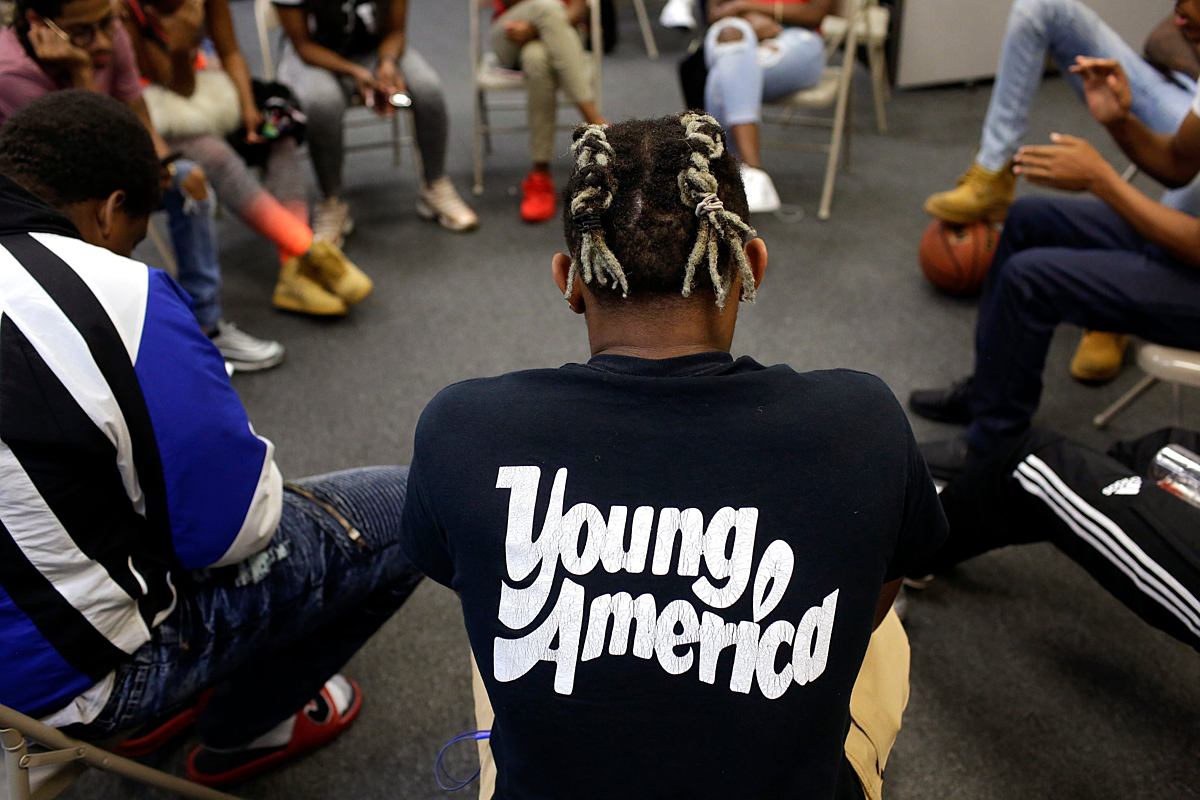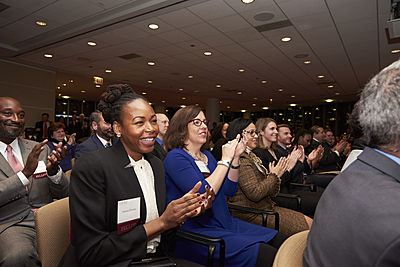In some Chicago neighborhoods young people are exposed to gun violence at rates almost 30 times higher than youths even a few blocks away—a dynamic that manifests itself in harms to mental health, emotional development, and academic engagement.
Confronted with this reality, the University of Chicago Crime Lab and Education Lab, now housed at the Harris School of Public Policy, launched a competition in 2015 seeking the design of an initiative to reduce violence among young people at high risk for involvement in violence, many of whom are disengaged from school and disconnected from programs that might help.
The venture selected was a collaboration between two local nonprofits. Children’s Home & Aid and Youth Advocate Programs (YAP), Inc. created Choose to Change (C2C), which provides six months of wraparound support and trauma-informed cognitive behavioral therapy for young people ages 13–18 who have faced considerable challenges including trauma exposure, justice system involvement, or school disengagement.
Six years later, the initiative is showing marked, enduring impact in reducing arrests of any kind while enhancing educational engagement.
“I wouldn’t call it a program,” C2C alum Malik Hicks told a group gathered at Wendell Phillips Academy in 2020. Mayor Lori Lightfoot came to the school to announce the city’s expansion of C2C. “I would call it a family. The excellent coaches of these two programs deserve the credit as to why I am standing here free, alive, and a Black man in Chicago.”
Simple program delivers complex benefits
C2C youth have 48 percent fewer violent-crime arrests than their control peers at the end of the program, a Crime Lab and Education Lab mid-study evaluation found in February 2020, when C2C had served more than 600 young people in the greater Englewood communities. In addition, the analysis found that youth who completed C2C were 39 percent less likely to have been arrested than their control group peers.
Another intriguing characteristic is the lasting impact of C2C. The labs’ research showed that C2C youth have 38 percent fewer arrests for violent crimes compared to the control group in the 18 months after the program ends. Two and a half years after completion of the program, the analysis found, C2C youth were 33 percent less likely to have any arrest at all compared to the control group.
C2C also improves educational engagement. The evaluation found that, compared to control peers, C2C youth attended an additional seven days of school in the year after the program start. Participants also have 32 percent fewer misconduct incidents in school.
 Image: Joshua Lott / NYTimes
Image: Joshua Lott / NYTimes
“Choose to Change is a really simple idea but it is complex in the benefits it offers young people,” said Julie Noobler, director of Metro Behavioral Health Services at Children’s Home & Aid.
The constructive, trusting relationships between C2C advocates (sometimes referred to as “super mentors”) and young participants combined with “robust and trauma-informed services and support is the secret sauce” that motivates the young people, Noobler added.
“We work to help young people understand how their choices are immobilizing them,” she said. “We don’t dictate the change. That’s all driven by the youth.”
Advocate-mentors and coaches stress the future, not the past
Beyond launching the competition that yielded C2C and evaluating the program, UChicago’s Crime Lab and Education Lab secured funding for early implementation of the initiative. The Labs also continue researching C2C, examining what works and what doesn’t and looking for ways to expand it.
School officials are the primary references for potential C2C candidates to the program, said Nour J. Abdul-Razzak, PhD’19, a post-doctoral fellow in the Crime Lab and Education Lab. Abdul-Razzak and Kelly Hallberg, scientific director of the Inclusive Economy Lab, are the principal investigators of Choose to Change.
Once a young person enrolls—YAP advocates often must approach a prospect several times before persuading the youth to participate—the advocate spends eight hours a week with the teenager to address barriers and challenges that might include unsafe passage to school, food shortages, or lack of clothing. The two set goals, which the advocate helps the participant meet. The advocate also may provide support to the participant’s family, Abdul-Razzak said.
About a month after starting with the young person, the advocate, who typically is from the same neighborhood as the participant, will make a “warm handoff’’ to a “coach,” a clinically trained therapist from Children’s Home & Aid. The coach will lead 12–16 trauma-informed cognitive behavioral therapy sessions known as SPARCS (Structured Psychotherapy for Adolescents Responding to Chronic Stress). Through exercises and conversations, the therapy helps youth understand the impact trauma has had in their lives. The effort also shows participants how to regulate their emotions and develop more resilient coping and problem-solving skills. Image: Joshua Lott / NYTimes
Image: Joshua Lott / NYTimes
“The trauma-informed approach that they take shifts the narrative from what’s wrong with you to what has happened to you and helps validate youth experiences and responses,” Abdul-Razzak said. “The program directors are also very thoughtful in how they approach the young people, by highlighting their strengths and their potential in the future.”
One key to the therapy’s effectiveness, Abdul-Razzak and others said, is that the advocate attends therapy with the young person then reinforces the concepts during their other interactions.
“We think there’s a lot of learning by doing happening,” Abdul-Razzak said.
That characteristic underscores YAP’s relentless engagement with students, something the organization believes is necessary to succeed with this challenging population and something that has impressed John Wolf, associate director of the Education Lab.
“The idea of not giving up on a person just rings so true for a lot of students who the system has failed—often at many points along the way,” said Wolf, a former teacher. “That commitment to young people really shines through.”
To date, C2C has enrolled nearly 1,000 young people on the South and West sides. The goal for next year is the support of an additional 500 youth for this program with YAP and Children’s Home & Aid, Abdul-Razzak said.
Chicago Public Schools making ‘significant investments’
C2C has impressed city and school leaders and gotten attention from at least one influential federal policymaker.
“Choose to Change has proven to be an evidenced-based intervention for our students who have been heavily impacted by exposure to violence and trauma,” Chicago Public Schools Chief Safety and Security Officer Jadine Chou said. Since 2018, the Mayor’s office and Chicago Public Schools (CPS) have invested millions to sustain and expand C2C.
And, this past year, CPS sought input from the Crime Lab and Education Lab on how to spend the school district’s $525 million in federal American Rescue Plan funds to tackle learning challenges exacerbated by the pandemic.
The Labs’ representatives pointed out that Choose to Change already has shown its effectiveness in reaching students who have disengaged from school. In addition, Abdul-Razzak’s team is composing a C2C program manual in collaboration with the program providers to guide other organizations seeking to implement the model.
“The need is so great that Youth Advocate Programs and Children’s Home & Aid might not be able to serve every young person directly,” Wolf said. “It’s really about taking what we’ve learned about best practices and working with our partners to disseminate those findings so that other organizations can help scale up this work.”
Chou added that as part of CPS’s plan for the federal funding, known as Moving Forward Together, “CPS has made significant investments in the Choose to Change program to ensure that our students have access to the necessary interventions that will support them with critical social and emotional skills as they return to in-person school.”
Also, part of CPS’s $18 million investment in efforts focused on student transitions and student and family involvement includes making summer jobs available to 250 students at risk for violence involvement in Choose to Change.
On the federal level, U.S. Sen. Dick Durbin, chairman of the influential Senate Judiciary Committee and a member of the Appropriation Committee, has met with Crime Lab and Education Lab representatives to learn of C2C’s crime reduction success.
In their own words
About two months after each cohort of C2C young people finish the program, UChicago’s Crime Lab and Education Lab organize focus groups to acquire feedback from the young people. Those interactions show how powerful their experiences have been.
The youth note that they’re more mature; that the program helped them “look at the world differently,” find a job, and develop critical and responsible thinking.
“As far as I could see,” one wrote, “I wasn’t going to make it to 20. Now I wake up [and] think about what I’m going to do right now and how it will affect things I do later.”
Participants praise their advocate-mentors for always being there, for creating trust, and guiding them to finish school and meet other goals.
“Influence, intelligence, experience,” one youth wrote about a mentor. “He’d been there, done that. You gotta swallow a lot of pride to change your life.
“You know how many people it take[s] to change one person?” the participant added. “It only take[s] this one person in six months to change me.”



